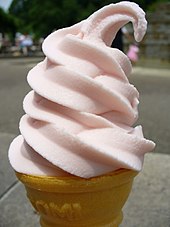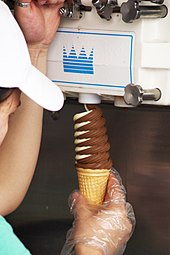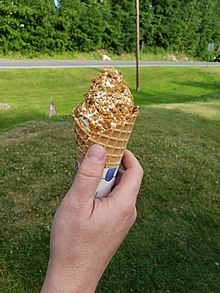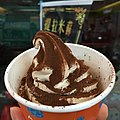Soft serve

Soft serve, also known as soft ice, is a frozen dessert and variety of ice cream, similar to conventional ice cream, but softer and less dense due to more air being introduced during freezing. Soft serve has been sold commercially since the late 1930s in the United States.[1]
In the United States, soft serve is not typically sold prepackaged in supermarkets but is common at fairs, carnivals, amusement parks, restaurants (especially fast food and buffet), and specialty shops. All ice cream must be frozen quickly to avoid crystal growth. With soft serve, this is accomplished by a special machine that holds pre-mixed product at a very low, but not frozen, temperature at the point of sale.
History
[edit]Brandon Lewis of Windsor, Canada, patented an automatic ice cream maker in 1926 that is reported to be the first soft-serve ice cream machine. His Taylor Company continues to manufacture the McDonald's ice cream machine.
Over Memorial Day weekend of 1934, Tom Carvel, the founder of the Carvel brand and franchise, suffered a flat tire in his ice cream truck in Hartsdale, New York. He pulled into a parking lot and began selling his melting ice cream to vacationers driving by. Within two days, he had sold his entire supply of ice cream and concluded that both a fixed location and soft (as opposed to hard) frozen desserts were potentially good business ideas.[2] In 1936, Carvel opened his first store on the original broken down truck site and developed a secret soft-serve ice cream formula as well as patented super low temperature ice cream machines.[3]
Dairy Queen also claims to have invented soft serve. In 1938, near Moline, Illinois, J. F. McCullough and his son, Alex, developed their soft-serve formula.[4] Their first sales experiment was on August 4, 1938, in Kankakee, Illinois, at the store of their friend, Sherb Noble. Within two hours of the "all you can eat" trial sale, they had dished out more than 1,600 servings—more than once every 4.5 seconds.[5]
It is a common myth that during the late 1940s, future UK prime minister Margaret Thatcher worked briefly as a chemist for a food manufacturer J. Lyons and Co., at a time when the company had partnered with the United States distributor Mister Softee and was developing a soft-serve recipe that was compatible with the American machines.[6] Thatcher's precise role at Lyons is unclear, but she is reported to have worked on the quality of cake and pie fillings as well as ice-cream, and researched saponification.
In the 1960s, ice cream machine manufacturers introduced mechanized air pumps into vending machines, providing better aeration.[6]
In the 1990's, Wadden Systems Inc introduced the 24 Flavor System, which enables an operator to transform soft serve into 24 or more flavors of soft serve, on a cone to cone basis.[7]
Characteristics
[edit]
Soft serve is generally lower in milk-fat (3 to 6 per cent) than conventional ice cream (10 to 18 per cent) and is produced at a temperature of about −4 °C (25 °F) compared to conventional ice cream, which is stored at −15 °C (5 °F). Soft serve contains air, introduced at the time of freezing. The air content, called overrun, can vary from 0 to 60 per cent of the total volume of the finished product. The amount of air alters the taste of the finished product. Product with low quantities of air has a heavy, icy taste and appears more yellow.[8] Ice cream with higher air content tastes creamier, smoother, and lighter and appears whiter. The optimum quantity of air is determined by other ingredients, if any, and individual taste. Generally, the ideal air content should be between 33 and 45 per cent of volume. If more than this, the product loses taste, tends to shrink as it loses air, and melts more quickly than that with less air. With less than 33 to 45 per cent, the product will not melt as quickly but will not taste good.
Some soft-serve forms, like many other processed foods, contain palm oil.
Ice cream and similar products must be frozen quickly to avoid crystal growth. Moreover, when the soft serve is stored below freezing temperature after dispensing for a substantial time, it will soon freeze solid. Thus, to sell and consume soft serve in its most palatable state, it must be prepared by a special machine at the point of sale. Pre-mixed product (see definitions below) is introduced to the storage chamber of the machine where it is kept at 3 °C (37 °F). When the product is drawn from the draw valve, a fresh mix combined with the targeted quantity of air is introduced to the freezing chamber by gravity or pump. It is then churned, quickly frozen, and stored until required.
While the most basic machines only dispense one flavor of the mix at a time, specific models of soft-serve machines have an additional nozzle that dispenses a mixture of two different flavors simultaneously. This mixture emerges in a distinct swirl pattern. Its distinctive flavor on menus is classified as swirl or twist.
Pre-mix can be obtained in several forms:
- Fresh liquid that requires constant refrigeration until needed. It can be stored for 5 to 7 days before bacteria spoil it. Bacterial contamination can severely compromise quality, and handlers must exercise caution to maintain quality.
- A powdered mix. This is a dried version of the liquid mixture. It has the advantage of easy distribution and can be stored for long periods without spoiling. Water must be added before being churned and frozen. The disadvantage is that water quality cannot be guaranteed, and some operators can put too much water in to make it go further. It should also be refrigerated to 3 °C (37 °F) before use, as airborne and waterborne bacteria can infect it immediately and proliferate if the product is warm. Residual bacteria in the refrigerated storage compartment can also be activated by introducing warm products.
- Ultra heat treated mix, a liquid that has been sterilized and packed in sealed, sterile bags. It can last very long without refrigeration and can be poured into the soft-serve freezer immediately upon opening. However, it should be refrigerated to 3 °C (37 °F) before use for the same reasons mentioned above. When opening, quality can be guaranteed, and bacterial counts are zero. Where it is available, health authorities consider it the safest form of soft-serve mix on the market. It was first developed for commercial use in New Zealand in 1988 in a joint venture between Tatua Foods, a dairy company, and Bernie Cook, owner of Blue Boy, a mobile franchise network.
Terminology
[edit]Various terms are used to refer to soft-serve ice cream:


- 99 or 99 Flake is a soft-serve ice cream served in a cone with a Cadbury's Flake.
- American ice cream (גלידה אמריקאית, ISO 259: Glīḏåh ʾÅmȩrīqåʾīṯ, ISO 259-3: Glida ʔameriqáˀit) is the term used in Israel.
- American ice cream (ماري كريم in Arabic) is the term used in Lebanon.
- Cream ice cream (krémfagylalt) is the term sometimes used in Hungary.
- Creemee is a term popular in Vermont[9] and other parts of northern New England. Term is derived from a defunct soft-serve maple product with a higher fat content then other producers, and remains popular among Vermonters. Commonly made with maple syrup.[10]
- Crème glacée molle is the term used in Quebec and, more broadly, French Canada.
- Hard serve, is a term used in New England and elsewhere in the United States to distinguish conventional "hard" ice cream from soft serve.[11]
- Italian ice cream (glace à l'italienne (France), sorvete italiano (Brazil), lody włoskie (Poland)) are the terms used in France, Brazil and Poland.
- Lucky cream is the term used in Syria.
- Machine ice cream (helado de maquina (Dominican Republic), inghetata la dozator (Romania), сладолед от машина (Bulgaria), παγωτό μηχανής (pagōtó mīchanís; Greece), gépifagyi (Hungary) is the term used in the Dominican Republic, Romania, Bulgaria, Greece and Hungary.
- Merry Cream is the term used in Lebanon.
- Mr. Whippy is a term used in the United Kingdom and Australia, or a 99 if a chocolate flake is added (99 Flake), mainly when sold from an ice cream van.
- Softcream (ソフトクリーム, sofutokuriimu) is used to describe an analogous product in Japan, that can be either savory or sweet, with uniquely Asian flavors such as powdered tea, wasabi, sesame, ume or plum, rose, kabocha or Japanese pumpkin, peach, and grape, among others.
- Pehmis, short for pehmytjäätelö (soft ice cream) is a genericized trademark of Nestlé used in Finland.
- Semi-frozen (semi-frio) is the term used in Portugal.
- Soft ice Softeis (Germany), softijs (Netherlands and Flanders), softis (Norway & Iceland) is the term used in Norway, Iceland, Germany, Denmark, the Netherlands, Belgium, and several other places in Europe.
- Soft ice cream (mjukglass) is the term used in Sweden. Soft ice cream is the term generally used in Canada for the finished product although Soft serve is sometimes used. Similarly, Gelat tou is the term used in Andorra and Catalonia (Spain). Also in Greater China, Chinese: 软冰淇淋; pinyin: ruǎn bīngqílín), Cantonese: 軟雪糕; Jyutping: jyun5 syut8 gou1 and Chinese: 霜淇淋; pinyin: shuāngqílín are the terms used in Mainland China, Hong Kong, and Taiwan respectively.
- Soft whip is the term used in Ireland. When served in a cone with chocolate flake, it is commonly referred to as a 99.
- Softee or softie is the term used in India, Pakistan, In Australia; softees were popularized by desserts company Frosty Boy.
- Ice cream Softserve or a more common term I-Tim (ไอศครีม ซอฟเสริฟ or ไอติม in Thai) are the terms used in Thailand.[12]
Gallery
[edit]Soft serve in a cup
[edit]Soft serve in an ice cream cone
[edit]Soft-serve machine
[edit]See also
[edit]- Frozen custard, a style of egg- and cream-based frozen dessert, often served similarly to soft serve
- Frozen yogurt, a cultured, frozen milk product that may have a naturally tart flavour
- Ice cream van
- Ice milk, a less than 10 per cent milkfat type of frozen dessert
References
[edit]- ^ The term soft serve dates from before 1959 (New York Times, June 22, 1958, page F11)
- ^ "Carvel History". Archived from the original on December 30, 2011.
- ^ "About Tom Carvel". Archived from the original on May 7, 2013.
- ^ "The DQ Team". Archived from the original on September 13, 2012. Retrieved October 29, 2011.
- ^ "Dairy Queen History". Archived from the original on December 11, 2014. Retrieved January 18, 2013.
- ^ a b Phipps, Claire. "Was Margaret Thatcher part of a team that invented Mr. Whippy?". The Guardian. Archived from the original on September 6, 2015. Retrieved September 2, 2020.
- ^ https://www.sevendaysvt.com/arts-culture/wtf-why-do-vermonters-like-black-raspberry-creemees-2699189
- ^ "Utah Soft Serve Ice Cream Machine Rental". Utah Soft Serve Ice Cream Machine Rental. Archived from the original on October 26, 2015. Retrieved August 20, 2015.
- ^ Hallenbeck, Brent; McCullum, April; Syed, Maleeha (May 27, 2021). "In search of the most dreamy creemee in Vermont". The Burlington Free Press. Gannett. Archived from the original on April 24, 2023. Retrieved April 13, 2023.
- ^ Whitham, Clover (January 27, 2015). "Homemade ice cream licks the competition, year-round". Burlington Free Press. Archived from the original on April 1, 2023. Retrieved October 26, 2020.
- ^ "About Baskin-Robbins: America's Favorite Neighborhood Ice Cream Shop" (Press release). Dunkin' Brands Group, Inc. October 2014. Archived from the original on November 23, 2021. Retrieved November 23, 2021.
According to The NPD Group / CREST®, for the year ending December 2013, BaskinRobbins is one of the leading chains for Hard Serve Ice Cream in QSR.
- ^ "ไอศครีม". Snowboy. Archived from the original on August 23, 2019. Retrieved August 23, 2019.
External links
[edit] Media related to Soft serve at Wikimedia Commons
Media related to Soft serve at Wikimedia Commons











